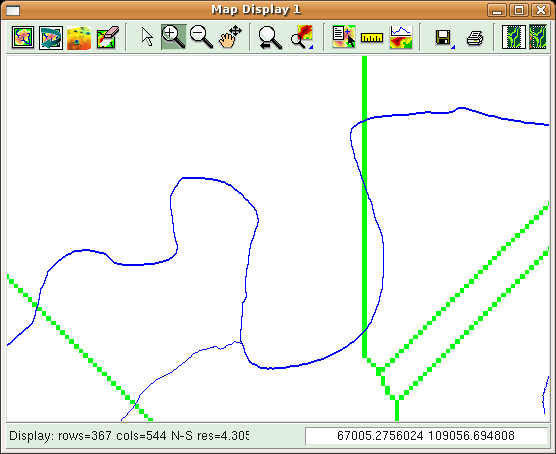Hi,
ok I had to learn that you can't compare the results of r.terraflow and
r.watershed regarding the watershed generation. I think r.watershed gives me
the better results, so I will try to use this module.
But I still have the problem with r.thin to get rid of the linear features
describing watersheds. The pics I had attached are, of course, the results
of thining my watersheds of r.terraflow. First pic result watersheds of
r.terraflow, second pic the thining result.
Any Ideas here?
Thanks in advance,
Christian
-----Ursprüngliche Nachricht-----
Von: Hamish [mailto:hamish_nospam@yahoo.com]
Gesendet: Mittwoch, 15. August 2007 08:02
An: christian.braun@tudor.lu
Cc: grassuser@grass.itc.it
Betreff: Re: [GRASS-user] Problems with r.terraflow and r.thin
christian.braun wrote:
I am currently working on the generation of watersheds for a small
european country;-) Due to the amount of data (4089x2860, res=20) I
have to use r.terraflow instead of r.watershed.
In my opinion the outcoming watersheds of r.terraflow are not really
compact, rather fuzzy at the borders. See attached file.
..
Whats going here?
maybe Helena and Laura's comments help:
http://article.gmane.org/gmane.comp.gis.grass.devel/16319
http://article.gmane.org/gmane.comp.gis.grass.devel/1442
searching the mailing lists turns up some more, such as:
http://thread.gmane.org/gmane.comp.gis.grass.user/16202/focus=16228
Could that be the problem for my results in r.thin, which are
completly unuseable? See attached file.
garbage in, garbage out of course. Make sure all your inputs are healthy
before undertaking the next step... I'm not familiar with your dataset so no
idea how good/bad r.thin did, or even what you are thinning.
(stream network?)
Any ideas to solve this problem?
Let GRASS 6.2.2's r.watershed run for a week or three until you get a
result. Try without the -m flag first, only use that if you get out-of-
memory errors. Eventaully it gets done, it just takes a while.
tip - set shell priority low before starting a long-running process:
GRASS> renice +19 -p $$
GRASS> r.watershed ...
You can make grass shell always start up at a lower priority by adding the
renice to ~/.grass.bashrc
Hamish

